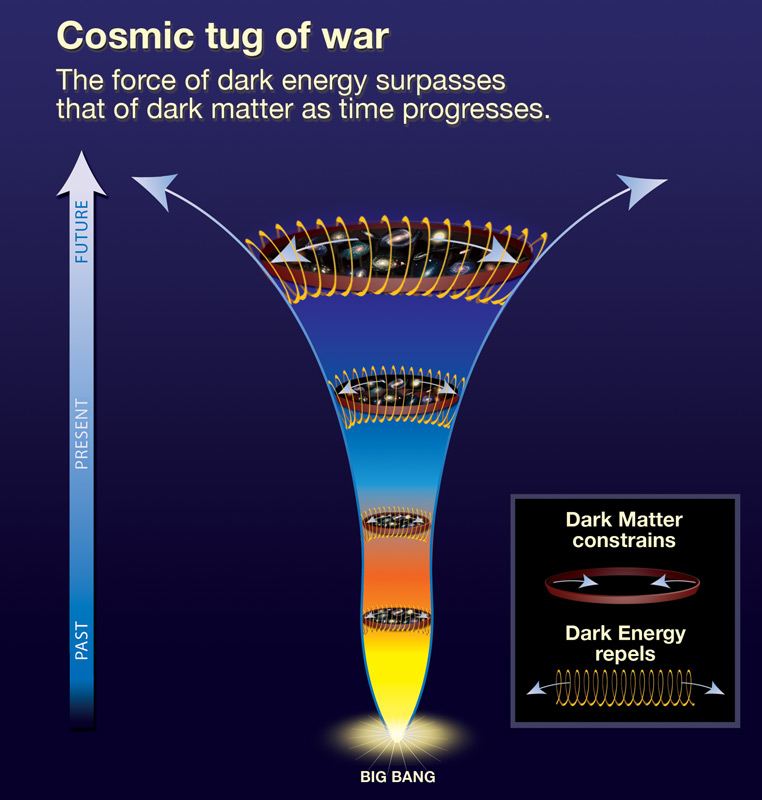
Dark energy is a mysterious force that plays a pivotal role in the universe’s accelerating expansion, raising compelling questions in astrophysics research. Recent findings from the Dark Energy Spectroscopic Instrument (DESI) collaboration highlight the potential evolution of dark energy, which has been traditionally viewed as a cosmological constant. By tracking the distribution of galaxies and quasars across vast distances, researchers have created the largest 3D map of our universe, offering unprecedented insights into how dark energy has influenced cosmic growth over the past 11 billion years. This groundbreaking analysis suggests that dark energy might not be a fixed entity, but rather one that could be weakening over time, challenging our understanding of the universe’s fate. As researchers delve deeper into these revelations, the concept of dark energy is set to reshape our comprehension of the cosmos and lead to innovative explorations of the universe’s fundamental workings.
The enigma of energetic voids in space, often referred to in terms of negative pressure, has provoked intense scrutiny among scientists dedicated to understanding the fabric of the universe. Alternative descriptions such as the cosmic backdrop and driving force of expansive dynamics reflect the ongoing quest for knowledge concerning this elusive phenomenon. Collaborative efforts like those of the DESI project involve rigorous cosmic data collection, aiming to elucidate the interplay between matter distribution and the implications for cosmic acceleration. As astrophysicists unravel the threads of this cosmic tapestry, the evolving understanding of dark energy invites renewed research endeavors and theoretical advancements in cosmology. Ultimately, by expanding our grasp on these cosmic forces, we stand to uncover new dimensions of the universe’s origins and its eventual fate.
The Role of Dark Energy in Universe Expansion
Dark energy plays a pivotal role in our understanding of the universe’s expansion. It is often described as a mysterious force pushing galaxies apart, causing the universe to accelerate in its expansion. Recent findings from the DESI collaboration suggest that the influence of dark energy might not be a constant force, but rather one that evolves over time. This new insight raises fundamental questions about the dynamics of cosmological constants and how they might influence the future trajectory of the universe.
As researchers delve deeper into the study of dark energy, they are using cutting-edge tools, like the DESI, to map its effects across vast distances in the cosmos. By analyzing over 14 million galaxies and quasars, scientists are uncovering subtle variations in the density and distribution of matter that could point to changes in dark energy’s potency. Such revelations could lead to a major shift in astrophysics research, fundamentally altering our understanding of the universe’s fate.
Insights from the Dark Energy Spectroscopic Instrument (DESI) Collaboration
The Dark Energy Spectroscopic Instrument (DESI) is at the forefront of astrophysical research, pulling together expertise from over 900 scientists across more than 70 institutions worldwide. This ambitious international endeavor aims to create a comprehensive 3D map of the universe while investigating the nature of dark energy. DESI’s latest report, based on three years of painstaking data collection, presents significant findings suggesting that dark energy may not be invariant, potentially challenging long-standing assumptions about its role in cosmic expansion.
Leading figures in the DESI collaboration, including Harvard’s Daniel Eisenstein, have contributed to groundbreaking algorithms and simulations that illuminate how dark energy interacts with matter over extensive periods. The team’s approach not only emphasizes the importance of precise distance measurements but also leverages Baryon Acoustic Oscillations as a cosmic ruler, allowing researchers to track the evolution of dark energy with remarkable accuracy. As data continues to stream in, DESI’s insights are poised to revolutionize our understanding of cosmological forces.
The Future of Cosmological Research Post-DESI Findings
With the debut of DESI’s Data Release 1, a treasure trove of information on millions of celestial objects is now accessible to the astronomical community. This resource is expected to propel diverse astrophysics research initiatives, leading to further investigations into galaxy evolution and the structure of the Milky Way. By empowering scientists with rich data sets, DESI is fostering an era of unparalleled exploration and discovery, as researchers strive to grasp the complexities of dark energy’s influence.
Moreover, the DESI collaboration’s findings underline the need for a more nuanced model of the universe’s expansion that accounts for the potential variability of dark energy. This paradigm shift could initiate a renaissance in cosmological theories, prompting astrophysicists to rethink how the cosmos is structured and its future trajectory. As research evolves, the contributions from DESI may also catalyze innovative insights into the cosmic web, an intricate network of galaxies that can reshape our grasp of cosmic origins.
Understanding the Cosmological Constant in Light of DESI Data
The cosmological constant has long been a cornerstone of modern cosmology, traditionally viewed as a static entity. However, recent evidence from the DESI collaboration indicates that this constant might not remain unchanged over time. Researchers are beginning to question whether our current models adequately depict the behavior of dark energy, especially concerning the accelerating expansion of the universe. This acknowledgment indicates a potential shift toward exploring alternative theories of gravity and energy dynamics.
As the implications of these findings spread through the scientific community, they encourage robust debates and discussions regarding the nature of dark energy and its role as the cosmological constant. Scholars will need to reconcile these unexpected results with established astrophysical principles, potentially leading to a revised understanding of the very fabric of space and time. The ongoing advancements in cosmology promise riveting discoveries that will impact how we comprehend our universe and its evolutionary trajectory.
Baryon Acoustic Oscillations: A New Standard Ruler for Cosmic Research
Baryon Acoustic Oscillations (BAO) serve as a remarkable template for measuring cosmic distances and aiding in the comprehension of dark energy’s role in the universe’s expansion. The patterns left by early cosmic events, observable through the large-scale distribution of galaxies, act as a cosmic ruler that evolves with time. The DESI’s large-scale mapping of these oscillations helps astronomers understand how dark energy interacts with matter over billions of years, offering critical insights into how the universe’s expansion accelerates.
By utilizing BAO as a benchmark for observational data, researchers can more accurately assess the dynamics of dark energy. The combination of this standard ruler with vast datasets, such as those brought forth by DESI, enhances the ability to discern subtle changes and evolution in dark energy’s influence. This leads to a more profound understanding of underlying cosmic structures and processes, ensuring that BAO remains an essential tool in ongoing astrophysical research.
Exploring Dark Energy’s Evolution Over 11 Billion Years
The recent analyses conducted by the DESI team reveal that dark energy’s influence has shifted over the past 11 billion years. This groundbreaking observation indicates that the forces driving the expansion of the universe may not only be significant but also varied in their intensity and effect. By examining the distance measurements and distribution data from millions of galaxies, astronomers are beginning to outline a timeline of dark energy’s evolution and its implications on our universe.
This insight into the long-term behavior of dark energy highlights its complex nature, suggesting that it could be subject to changes not previously accounted for in the standard model of cosmology. The nuance surrounding dark energy’s evolution urges the scientific community to re-evaluate existing paradigms and models that govern our understanding of cosmic expansion. As the DESI survey continues, further revelations regarding dark energy’s evolution could emerge, presenting new pathways for exploration in astrophysics.
Collaboration and Data Sharing: Advancements in Astrophysics Research
The success of the DESI collaboration is largely attributed to the cooperative efforts among scientists from diverse geographic and academic backgrounds. With more than 900 researchers participating, the initiative not only enhances specific astrophysical investigations but creates a platform for knowledge sharing and skill cross-pollination. This collaborative approach enables contributions ranging from sophisticated data analysis to educational outreach, reinforcing the significance of teamwork in exploring cosmic mysteries.
Moreover, the wide availability of data through platforms like arXiv fosters a culture of openness in research, allowing both seasoned experts and emerging scientists to access and build upon the findings. As detailed data on dark energy and cosmic structures become more accessible, the potential for innovation in the field expands exponentially. By promoting collaboration and data sharing, astronomers around the world can work together to address some of the most profound questions about our universe’s history and future.
Galaxies and the Cosmic Web: Understanding Our Place in the Universe
The intricate relationship between galaxies and the cosmic web is a central theme in astrophysics, illustrating the large-scale structures that characterize our universe. With the results from DESI, researchers have begun to unravel the connections between dark energy and the formation of galaxies. This understanding is crucial for depicting how dark energy affects galaxy clusters while influencing their evolutionary paths over cosmic time.
By mapping these galaxies and their connections within the cosmic web, scientists gain valuable insights into the role of dark energy in shaping cosmic structures. Knowledge regarding the evolution and distribution of matter, coupled with the dynamics of dark energy, helps us ascertain the fundamental forces at play in the growth of the universe. Continuous research into these dynamics promises to enrich our comprehension of how the universe evolves and how we fit into this grand cosmological narrative.
The Implications of Dark Energy Findings on Cosmology
The revelations observed from the dark energy data proffered by the DESI collaboration carry significant implications for the broader field of cosmology. If dark energy is indeed evolving and not a static cosmological constant, this alters how physicists and astronomers must construct their models of the universe. Such a finding prompts a re-evaluation of foundational concepts and encourages exploration of alternative theories that might better capture the complexities of cosmic expansion.
As the field responds to these developments, the ongoing research into dark energy will not only refine our existing models but also foster innovative approaches to understanding cosmological phenomena. This evolution of scientific thought can lead to groundbreaking discoveries, possibly unveiling new aspects of the universe that remain hidden. Engagement with these findings will be critical as the scientific community endeavors to decode the intricacies surrounding dark energy and its ultimate significance.
Frequently Asked Questions
What is dark energy and how does it relate to the universe expansion?
Dark energy is a mysterious force that constitutes about 68% of the universe and is believed to be responsible for its accelerating expansion. It counteracts the attractive force of gravity, enabling galaxies to move apart from each other faster over time.
How does dark energy evolution impact our understanding of the universe?
Recent findings from the DESI collaboration suggest that dark energy might be evolving, which could alter our current understanding of the cosmological constant — a key factor in the standard model of cosmology. This evolving nature may influence future theories about the fate of the universe.
What role does the DESI collaboration play in dark energy research?
The DESI collaboration, involving over 900 researchers globally, is pivotal in dark energy research. By creating the largest 3D map of the universe, it helps track dark energy’s influence on the distribution of matter and enhances our understanding of its role in cosmic expansion.
What are the implications of dark energy being a cosmological constant?
If dark energy is confirmed as a cosmological constant, it implies a fixed energy density filling space homogeneously. However, recent evidence from DESI suggests that dark energy might weaken over time, challenging this conception and requiring a reassessment of cosmological models.
How is dark energy tracked using Baryon Acoustic Oscillations?
Dark energy is tracked through patterns in matter distribution known as Baryon Acoustic Oscillations. These patterns serve as a ‘standard ruler’ for measuring how the universe expands over time, providing critical insights into the behavior of dark energy throughout cosmic history.
What future research could dark energy findings from DESI lead to?
The evolving insights on dark energy from DESI could lead to new astrophysics research avenues, improving our understanding of galaxy formation, the cosmic web, and possibly, the ultimate fate of the universe.
Why is the DESI data important for astrophysics research?
The data released by DESI, which includes information on millions of celestial objects, is essential for a range of astrophysical research. It enables detailed studies of galaxy evolution, dark energy effects, and the large-scale structure of the universe.
What are the key findings related to dark energy from the March 19 DESI analysis?
The recent DESI analysis indicates that dark energy’s effect may have changed over the last 11 billion years, suggesting a weakening influence that could revise theories surrounding the universe’s expansion and its fate.
How do researchers measure the strength of dark energy over time?
Researchers measure dark energy’s strength by examining the sizes of Baryon Acoustic Oscillations across different epochs in the universe, allowing them to assess how its influence has varied over cosmic history.
What is the significance of the latest dark energy results announced by the DESI collaboration?
The latest results from DESI signify a potential shift in understanding dark energy, revealing that its effects may be changing, which could require updates to current cosmological theories.
| Key Point | Details |
|---|---|
| Dark Energy Behavior | Recent findings suggest that dark energy, previously thought to be a constant, may be weakening over time. |
| Role of DESI | The Dark Energy Spectroscopic Instrument (DESI) tracks the influence of dark energy through a detailed 3D mapping of the universe. |
| Historical Analysis | The new analysis looked at the influence of dark energy over the past 11 billion years. |
| Collaboration Details | The research involves over 900 collaborators from 70 institutions worldwide. |
| Significance of Findings | The research calls for a potential update of the standard model of cosmology due to evolving dark energy effects. |
| Public Data Access | DESI’s Data Release 1 is now available for public use, providing detailed data on millions of celestial objects. |
| Research Applications | Researchers are using DESI data for various studies, including galaxy evolution and the structure of the Milky Way. |
Summary
Dark energy continues to be a crucial topic in understanding the universe. Recent research from the collaboration involving the Dark Energy Spectroscopic Instrument (DESI) suggests significant developments regarding the behavior of dark energy over time. As scientists study how dark energy influences the universe’s expansion, the implications of these findings may lead to a revision of existing cosmological models. This evolution in our understanding of dark energy is essential for comprehending the ultimate fate of the universe.


